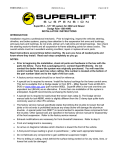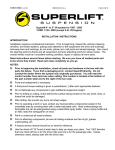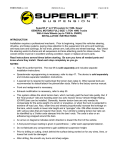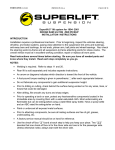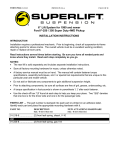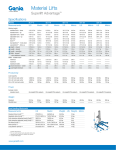Download 9630 Instructions
Transcript
FORM #4660.10-121505 PRINTED IN U.S.A. PAGE 1 OF 13 SUPERLIFT SUSPENSION SYSTEMS 300 Huey Lenard Loop Rd. West Monroe, Louisiana 71292 Phone: (318) 397-3000 Sales / Tech: 1-800-551-4955 FAX: (318) 397-3040 www.superlift.com Superlift 6” lift system for 2003 and Newer Dodge Ram 3/4-ton and 1-ton 4WD INSTALLATION INSTRUCTIONS INTRODUCTION Installation requires a professional mechanic. Prior to beginning, inspect the vehicles steering, driveline, and brake systems, paying close attention to the suspension link arms and bushings, anti-sway bars and bushings, tie rod ends, pitman arm, ball joints and wheel bearings. Also check the steering sector-to-frame and all suspension-to-frame attaching points for stress cracks. The overall vehicle must be in excellent working condition; repair or replace all worn parts. Read instructions several times before starting. Be sure you have all needed parts and know where they install. Read each step completely as you go. NOTES: • IMPORTANT: If the vehicle is equipped with a manual transmission, a transfer case indexing ring (Part # 4663) may be required to alleviate front driveline vibration. The indexing ring is sold separaly and includes its own instruction form. • On 2006 and Newer models equipped with a gas engine, exhaust modifcations will be required for front driveshaft clearance. If necessary, the vehicle can be driven a short distance to have the exhaust work performed once the installation is complete. • This system will accommodate up to a 37” tall tire mounted on an 8” wheel with a minimum of 4-5/8” backspacing. The use of a wider wheel and / or a wheel with less backspacing than specified may result in tire-to-fender contact. • Special tools are recommended to detach/attach the pitman/idler studs. Refer to the factory service manual. • Front end realignment is necessary. • An arrow on diagrams indicates which direction is toward the front of the vehicle. • A foot-pound torque reading is given in parenthesis ( ) after each appropriate fastener. • Do not fabricate any components to gain additional suspension height. • Prior to drilling or cutting, check behind the surface being worked on for any wires, lines, or hoses that could be damaged. • After drilling, file smooth any burrs and sharp edges. • Paint or undercoat all exposed metal surfaces. • Prior to attaching components, be sure all mating surfaces are free of grit, grease, undercoating, etc. • A factory service manual should be on hand for reference. FORM #4660.10-121505 • Use the check-off PRINTED IN U.S.A. PAGE 2 OF 13 box “” found at each step to help you keep your place. Two “” denotes that one check-off box is for the driver side and one is for the passenger side. Unless otherwise noted, always start with the driver side. PARTS LIST … The part number is stamped into each part or printed on an adhesive label. Identify each part and place the appropriate mounting hardware with it. PART NO DESCRIPTION NEW ATTACHING HARDWARE (Qty.- if more than one) (Qty.- if more than one) 01-246 ......................... front coil spring, driver side 02-246 ......................... front coil spring, passenger side 55-14-4660 .................. (2) lower link arm.......................... (4) bushing half (2) 1-1/8” OD x 2-1/2” sleeve 55-15-4660 .................. (2) upper link arm......................... (4) bushing half extended description (2) 1” OD x 2-1/4” sleeve 04-4640 ....................... pitman arm 55-05-4640 .................. front track bar bracket.................. (1) 9/16” x 3” bolt (1) 9/16” stover nut (1) 1/2” x 3” bolt (1) 1/2” x 1-1/4” bolt (1) 1/2” USS washer (2) 1/2” stover nut (1) 14mm x 80mm bolt (1) 14mm nut (1) 3/4” ID x 1-3/8” sleeve (1) square washer 55-08-4640 .................. (2) front anti-sway bar links.......... (1) 7/16” nyloc nut Grease upon installation (1) 7/16” SAE washer (1) hardware pack 55-09-4660 .................. (2) compression travel stop.......... (2) 3/8” x 1” bolt extension, lower, front (1) 3/8” nyloc nut 55-10-4640 .................. (2) compression travel stop plate, upper, front 01-300 ......................... (2) poly compression travel stop 55-03-4660................... emergency brake cable drop........ (2) 3/8” x 1-1/4” bolt bracket (2) 3/8” SAE flat washer (2) 3/8” nyloc nut (2) 5/16” x 1” self-tapping bolt 55-11-4660 .................. (2) compression travel stop.......... (2) 3/8” x 1” bolt extension, rear (2) 3/8” USS washer (2) 3/8” nyloc nut 55-12-4660 ................ automatic transmission drop........ (2) 10mm nut FORM #4660.10-121505 PRINTED IN U.S.A. PAGE 3 OF 13 bracket, diesel, 2003 – 2005 55-18-4660................. automatic transmission drop........ (2) 10mm nut bracket, diesel, 2006 and Newer OR 55-13-4660 ................ transmission drop bracket,........... (2) 10mm nut gas V-8, 2003 – 2005 55-19-4660................. transmission drop bracket,........... (2) 10mm nut gas V-8, 2006 and Newer 55-21-4660................... rear E-brake cable........................ (1) 1/4” x 1” bolt extension bracket (1) 1/4” USS washer (1) 1/4” nyloc nut (1) 5/16” x 1” self-tapping bolt 88510........................... (2) shock absorber, front.............. (2) shock boot, yellow (2) hardware pack and cable tie 85150........................... (2) shock absorber, rear............... (2) shock boot, yellow 2 (2) hardware pack and cable tie (4) 9/16” USS washer 0034............................. Superlift badge............................. alcohol wipe pad 00461........................... decal, "Warning To Driver" FRONT DISASSEMBLY 1) PREPARE VEHICLE... Place vehicle in neutral. Raise front of vehicle with a jack and secure a jack stand beneath each frame rail, behind the lower trailing arms. Ease the frame down onto the stands, place transmission in low gear or “park”, and chock rear tires. Position the jack so that it supports, but does not raise, the front axle. Remove front tires. 2) ANTI-SWAY BAR LINKS… Disconnect the anti-sway bar links from both the bar and the frame. Discard the links but save all bushings for re-use. 3) SHOCKS… Remove the lower shock bolt, followed by the bolts attaching the shock tower to the upper coil bucket. Remove the shock from the tower, but save all hardware for re-use. 4) TRACK BAR… Disconnect the track bar from its upper mounting point on the frame and rest it on the axle. It may be helpful to loosen the lower track bar bolt to relax the lower bushing. Save all hardware for re-use. 5) DRAG LINK… Remove the cotter pin and castellated nut from the drag link where it attaches to the pitman arm. Using the appropriate tool, separate the drag link from the pitman arm. 6) BRAKE HOSES… On each side, remove the brackets securing the brake hoses to the rear of the link arm bracket on the axle. Save the hardware and bracketry for re-use. FORM #4660.10-121505 PRINTED IN U.S.A. PAGE 4 OF 13 7) COIL SPRINGS… Ease down the jack supporting the front axle enough to facilitate removing the springs. 8) COMPRESSION TRAVEL STOPS… Remove and discard the factory compression travel stops. FRONT ASSEMBLY 9) PITMAN ARM… Note the orientation of the pitman arm in relation to the steering sector, then remove the nut securing the pitman arm to the steering sector shaft. Using the appropriate puller tool, remove the pitman arm from the sector shaft. Line up the indexing splines of the #04-4640 pitman arm with the steering sector shaft and secure using the factory hardware. After making sure the pitman arm is indexed the same as the original arm, tighten the sector shaft nut (225). 10) MARKING ECCENTRIC CAM BOLT LOCATION… The lower trailing links (one on each side) are secured to the axle via eccentric cam bolts. Rotating these bolts changes front axle alignment. It is important that the eccentrics be installed in exactly the same position as they were removed to serve as a baseline for final alignment. Scribe a line on each eccentric and the flanges they contact for future reference. 11) UPPER AND LOWER LINK ARMS… NOTE: If the optional Rockrunner adjustable links have been purchased, install now per separate instructions. The following steps should be performed one side at a time. Start on the driver side. Assemble the bushing halves and sleeves in the #55-14-4660 lower link arms and #55-154660 upper link arms. Thoroughly lubricate all of the bushings and sleeves with a siliconbased grease. Also note that the 2-1/2” long sleeves install in the lower links, while the 21/4” long sleeves install in the upper links. Remove the bolts securing the upper and lower trailing links to the frame and axle. Discard the links, but save all hardware for re-use. Install the “14” and “15” link arms using the factory hardware. The eccentric cam bolts are reinstalled in the lower link arms at the axle, and they should be rotated to line up the marks made previously. Snug, but do not tighten at this time. NOTE: Be sure the “14” and “15” link arms are positioned properly in their respective lower and upper arm positions. The part numbers are stamped in each arm for reference. FORM #4660.10-121505 PRINTED IN U.S.A. PAGE 5 OF 13 12) COMPRESSION TRAVEL STOP EXTENSIONS… [DIAGRAM 1] On each side, insert a #5510-4640 compression stop plate inside the factory compression stop cup attached to the bottom of the frame as shown. The bracket can be inserted by angling it on its side enough to get it past the lip in the cup. Position the bracket so that the welded nuts are facing downward. Position the compression travel stop extension bracket (#55-09-4660) as shown in Diagram 1 and secure to the “10” bracket using the supplied 3/8” x 1” bolts. Tighten (23). Attach a #01-300 poly compression travel stop to the “09” bracket using the supplied 3/8” nyloc nut. Tighten (23). 13) COIL SPRINGS… NOTE: On 2006 models equipped with a gasoline engine, it will be necessary to cut and modify the exhaust crossover pipe for front driveshaft clearance when the axle is at full extension. as the axle is lowered to install the coil springs. In some cases it may be necessary to remove the front driveshaft temporarily until modifications can be made. Lower the front axle enough to facilitate the installation of the coil springs. Position the coil springs (#01-246 driver side and #02-246 passenger side) on the coil buckets, then raise the front axle enough to seat and hold them in place. NOTE: The coil springs are side-specific and must be installed correctly in order to gain even suspension lift. For reference, the driver side coil spring is 23-3/4” tall and the passenger side is 23-1/2” tall. 14) SHOCK ABSORBERS… Install the bushings, sleeves, shock boots, and stickers on the #88510 shock absorbers. Position the shocks inside the coil springs with the stem end of the shock facing upward. Secure the bottom end of the shock using factory hardware and tighten (89). Position a washer and bushing on the shock stem and then reattach the shock tower to the upper coil seat using the factory hardware (55). Install the remaining bushing and washer on the shock stem and tighten until the bushings swell slightly. 15) TRACK BAR BRACKET… [DIAGRAM 2] Position the track bar bracket (#55-05-4640) on the factory upper track bar mount as shown. Insert the supplied 3/4” ID x 1-3/8” long sleeve inside the factory mount and line it up with the mounting hole. Install the supplied 9/16” x 3” bolt and stover nut FORM #4660.10-121505 PRINTED IN U.S.A. PAGE 6 OF 13 through the “05” bracket, factory mount, and sleeve, then secure using the supplied 9/16” stover nut. Snug, but do not fully tighten at this time. NOTE: Be sure the bracket is positioned properly on the factory track bar bracket. The front lip of the Superlift bracket should be positioned in front of the factory track bar mount and crossmember, while the rear lip of the Superlift bracket installs in front of the rear lip of the factory track bar mount. In other words, the Superlift bracket steps forward (toward the front bumper) slightly when viewed from the side of the vehicle. Refer to Diagram 3. Install the 1/2” x 3” bolt through the “05” bracket and slotted existing hole in the frame crossmember as shown in Diagram 2. The bolt should be installed from the bottom. Install the supplied square washer and 1/2” nyloc nut. Tighten the 9/16” bolt (82) and 1/2” bolt (57). [DIAGRAM 3] Using the “05” track bar bracket as a template, drill a hole in the crossmember using a 17/32” bit as shown. Install the supplied 1/2” x 1-1/4” bolt through the drilled hole and secure using a 1/2” nyloc nut (57). NOTE: It may be easier to reattach the track bar once the vehicle is on the ground with the suspension supporting the weight of the vehicle. Raise the track bar and line it up with the mounting hole on the “05” bracket. Secure the bar with the supplied 14mm x 80mm bolt and tighten (150). 16) BRAKE HOSE BRACKETS… Reattach the factory brake hose brackets to their factory location on the axle trailing link brackets using the factory hardware and tighten (7-1/2). 17) ANTI-SWAY BAR LINKS… Install the grease fittings in the swivel end of each #55-08-4640 anti-sway bar link. Using the bushing from the factory anti-sway bar links, attach the stem end of the #55-08-4640 anti-sway bar links to the anti-sway bar.and loosely secure with the supplied nyloc nut. Slide the supplied 7/16” SAE washer on the stud of the swivel end on the “08” links, then lower the bar enough to insert the swivel end in the factory link attachment point on the axle. It may be necessary to thread the stud into the mount, as clearance is tight. Be sure to FORM #4660.10-121505 PRINTED IN U.S.A. PAGE 7 OF 13 position the grease fitting so that it is easily accessible. Secure using the hardware found in the small hardware packs. NOTE FOR 2006 AND NEWER MODELS: Place the supplied 9/16” OD x 9/16” long sleeve over the threaded stud of the swivel link prior to inserting the links in the axle attachment point. Tighten the swivel end (37) of the links, then tighten the stem end until the bushings swell slightly. Grease the swivel end of each link. NOTE: The swivel links must be serviced according to the routine maintenance schedule for the vehicle. Failure to do so will result in premature wear of the links and unsatisfactory performance. 18) DRAG LINK… Reattach the drag link to the pitman arm using the factory nut and the supplied cotter pin. Tighten (65). REAR PROCEDURE 19) REAR BLOCK KIT… Use a floor jack positioned under the rear axle to raise the vehicle. Place jackstands under the framerails a few inches in front of the forward hanger for the rear springs. Ease the jack down until the frame is resting on the stands but keep a slight load on the jack. If the front has been placed back on the ground, chock the front tires to prevent the possibility of vehicle movement. Remove the tires, U-bolts, and shocks. Lower the axle by carefully easing down the jack. Do not overextend the brake lines and axle vent hoses. NOTE: The spring perches are prone to collapse or warp where the leaf springs or blocks seat on the axle, especially towards the ends. Without a perfectly flat mounting surface, the block may fail and “roll” out off of the perches. Check to make sure the perches are flat using a straightedge before proceeding. Make sure the top of the spring perches and the bottom of the springs are clean and free of any debris. Position the Superlift blocks in between the leaf springs and the spring perches. Notice that the top of the blocks are flat but have an offset center pin. Position the block so that the center pin is shifted forward. Install the supplied U-bolts and plates, then torque the bolts in an “X” pattern to the following specifications. FORM #4660.10-121505 PRINTED IN U.S.A. PAGE 8 OF 13 SUPERLIFT U-BOLT TORQUE GUIDE NOTE: Torque specifications apply to Superlift U-bolts only DESCRIPTION PLATED (lb-ft) PLAIN FINISH (lb-ft) ½” dia., up to 13” long 57 92 9/16” dia., up to 13 ½” long 82 131 9/16 dia., 13 ½” and longer 106 185 5/8” dia., up to 14 ½” long 112 181 5/8” dia., 14 ½” and longer 145 256 20) REAR SHOCK ABSORBERS… Assemble the bushings, sleeves, shock boots, and decals on the #85150 rear shocks. Install the shock absorbers using the factory hardware. On the lower mounts, position 9/16” USS washers between the mount and the shock bushing, so that the bushing is sandwiched by the washers and shock mount. Tighten the upper and lower mounts (100). 21) COMPRESSION TRAVEL STOP EXTENSIONS… On each side, unbolt the factory compression travel stops from the frame. Save all hardware for reuse. [DIAGRAM 4] On each side, attach a #55-11-4660 extension travel stop extension to the frame using the supplied 3/8” x 1” bolts and nyloc nuts. The bracket should be positioned so that it steps rearward (toward the rear bumper) as shown. Tighten (23). Attach the factory compression travel stops to the extension brackets using the factory hardware and tighten (30). 22) EMERGENCY BRAKE CABLE RELOCATION… NOTE: Avoid damaging any of the cable retaining clips and connectors, and keep all hardware for re-use. FORM #4660.10-121505 PRINTED IN U.S.A. PAGE 9 OF 13 Locate the emergency brake cable tensioner assembly on the driver side frame rail just forward of the rear spring hanger. Note that the single cable coming from the pedal inside the cab splits into two cables at the tensioner assembly; one cable goes to the driver side brake and the other to the passenger side brake. Make a note of where these two cables attach to the tensioner assembly. Loosen the adjuster nut enough to unclip the passenger side cable from the cable connector. It will be necessary to bend the small metal tab on the connector with a screwdriver in order to disconnect the cable. Once the passenger side cable is free, unclip the driver side cable from the tensioner assembly. Using a pair of pliers to hold in the prongs of its retaining clip, remove the passenger side cable from the tensioner assembly. Remove the emergency brake cable hanger that is mounted in the driver side rear fender well. Save the hanger and hardware for re-use. Pull both the driver and passenger side cables out of their respective holes in the frame and then re-route them so that they pass beneath the spring near the rear spring eye. [DIAGRAM 5] Position the #55-03-4660 mounting bracket as shown and loosely secure it to the lower hole in the frame originally used to retain one of the e-brake cables using supplied 3/8” x 1-1/4” bolt, flate washer, and nyloc nut. Snug, but do not tighten at this time. Using the “03” bracket as a template, drill a 13/32” hole as shown in Diagram 5. Install the supplied 3/8” x 1-1/4” bolt in the hole just drilled and secure using the supplied flat washer and nyloc nut. Tighten both 3/8” bolts (23). As noted in Diagram 5, attach the passenger side e-brake cable to the upper hole and the driver side e-brake cable in the lower hole in the “03” bracket. Be sure the prongs of the factory cable retaining clips are spread enough to secure each cable. [DIAGRAM 6] 2003-2005 MODELS: Position the factory e-brake cable hanger on both cables, then locate the hanger on the frame as shown. Drill two pilot holes in the frame using a 17/64” bit, then secure the hanger to the frame using the supplied 5/16” x 1” selftapping bolts (13). Do not overtighten the 5/16” bolts. [DIAGRAM 7] 2006 AND NEWER MODELS: Position the factory E-brake hanger on both cables, then attach the supplied #55-21-4660 relocation bracket to the hanger using the supplied 1/4” x 1” bolt, washer, and nyloc nut. Locate the bracket on the frame as shown and drill a 17/64” mounting hole. Secure the bracket to the frame with the supplied 5/16” x 1” self-tapping bolt (13), then tighten the 1/4” bolt (76 in-lb.). FORM #4660.10-121505 PRINTED IN U.S.A. PAGE 10 OF 13 Reattach the e-brake cables to the tensioner assembly in the reverse order of how they were removed and adjust the tension of the cables per the procedure found in the factory service manual. FINAL PROCEDURES 23) TIRES / WHEELS... [DIAGRAM 8] Tighten the lug nuts (145) in the sequence shown. WARNING: When the tires / wheels are installed, always check for and remove any corrosion, dirt, or foreign material on the wheel mounting surface, or anything that contacts the wheel mounting surface (hub, rotor, etc.). Installing wheels without the proper metalto-metal contact at the wheel mounting surfaces can cause the lug nuts to loosen and the wheel to come off while the vehicle is in motion. WARNING: Retighten lug nuts at 500 miles after any wheel change, or anytime the lug nuts are loosened. Failure to do so could cause wheels to come off while vehicle is in motion. 24) CLEARANCE CHECK... With the vehicle still on jack stands, and the suspension “hanging” at full extension travel, cycle steering lock-to-lock and check all components for proper operation and clearances. Pay special attention to the clearance between the tires / wheels and brake hoses, wiring, etc. Lower vehicle to the floor. Tighten the upper link arm bolts (120) and lower link arm bolts (160) at the axle and frame. 25) FINAL CLEARANCE and TORQUE CHECK... With vehicle on floor, cycle steering lock-to-lock and inspect the tires / wheels, and the steering, suspension, and brake systems for proper operation, tightness, and adequate clearance. 26) HEADLIGHTS... Readjust headlights to proper setting. 27) AUTOMATIC TRANSMISSION DROP BRACKET… NOTE: If the vehicle is equipped with a manual transmission, a transfer case indexing ring (Part # 4663) may be required to alleviate front driveline vibration. This indexing ring is sold separately and includes its own instruction form. Refer to those instructions and install now, then proceed to step 28. The transmission drop bracket supplied with this system will not be used with any manual transmissions. NOTE: Depending on the vehicle’s year, model, and powertrain combination, there may be some minor modifications required in order to gain an adequate amount of slack or clearance for electrical wires, linkages, plumbing, and exhaust connections between the powertrain and the frame. Before you begin, closely examine all connections running FORM #4660.10-121505 PRINTED IN U.S.A. PAGE 11 OF 13 between the powertrain and the frame and loosen or disconnect any lines, hoses, or linkages that you suspect might not have adequate length or clearance once the transmission has been relocated. Make a list of all connections affected so that so that you will have a checklist of things to address once installation is complete. Place vehicle on level ground and put the transmission in “Park” or Low gear. Set the parking brake. Loosen, but do not remove, any exhaust and intercooler clamps / bands that may be affected by the change in position of the powertrain. Be especially mindful of turbo couplings, if applicable. Place a jack under the transmission and raise it enough to relieve the weight on the crossmember and supports. WARNING: Do not leave the powertrain unsupported at any time while installing the transmission drop bracket or damage to various components will result. Note the orientation of the factory transmission bracket, then remove the bolts securing the bracket between the transmission and the rubber transmission mount on the crossmember. Install and secure the Superlift transmission drop bracket to the transmission and secure using the factory hardware (50). Lower the transmission until the bracket rests against the transmission mount and crossmember. Place the remaining bolts through the crossmember and bracket, then secure using the supplied 10mm nuts (50). Check for adequate clearance between the engine’s fan and the fan shroud, radiator, and all other underhood components. Make any necessary modifications to ensure the fan operates without any obstructions. Using the checklist made earlier, relocate or re-route all hoses, linkages, and wires as necessary in order to ensure an adequate amount of slack in these components between the frame the the transmission in its new location. Tighten all fittings and clamps, and top off fluids as necessary. Start the engine and double-check fan clearance as well as any fittings for signs of leakage and tighten or repair as necessary. 28) ALIGNMENT AND CENTERING THE STEERING WHEEL... NOTE: The vehicle must be aligned to factory specifications by a certified alignment professional. If the lower link arm cam bolts were installed in exactly the same position they were removed (reference step 10), then caster and camber are close enough to drive the vehicle safely and slowly to an alignment facility after performing the following steps. With the vehicle on the ground and the suspension supporting vehicle weight, observe the angle of the front driveshaft in relation to the front axle pinion. The pinion needs to be close to parallel to the driveshaft (no more than a 1 to 2 degree angle present) or there will be a possibility of driveline vibration. Loosen the cam bolts on the lower link arms and rotate FORM #4660.10-121505 PRINTED IN U.S.A. PAGE 12 OF 13 them until the pinion is 1 to 2 degrees down from parallel with the front driveshaft. Tighten the cam bolts (160). IMPORTANT: Raising the pinion to match driveshaft angle will decrease caster. There must be at least 2 to 3 degrees of positive caster present after the correction of the driveshaft angle. If there is not enough caster present after aligning the pinion with the driveshaft, rotate the pinion downward until the minimum caster specification is achieved. Be sure the steering wheel is unlocked. Position the passenger side front tire so that it is pointed straight ahead. You may want to use a long straightedge (such as a piece of pipe or string) positioned against the front and rear passenger side tires for reference. Loosen the adjuster sleeve on the drag link (the link that runs from the passenger side knuckle to the pitman arm) and rotate the sleeve until the steering wheel is straight, or “centered,” then tighten the sleeve clamps (45). To reach an initial toe setting, measure at a consistent point near the center of the tread on the front and rear of the tires. Note the difference in measurement from front to rear. Loosen the clamps on the tie rod adjustment sleeve (the link that runs from the drag link to the driver side knuckle) and make adjustments as necessary until the front measurement is 1/10th of an inch shorter than the rear. Tighten the adjuster clamps (45). Drive the vehicle safely and slowly to a facility that can perform a professional alignment. 29) SUPERLIFT WARNING DECAL... Install the WARNING TO DRIVER decal on the inside of the windshield, or on the dash, within driver’s view. Refer to the “NOTICE TO DEALER AND VEHICLE OWNER” section below. IMPORTANT PRODUCT USE INFORMATION As a general rule, the taller a vehicle is, the easier it will roll over. Offset, as much as possible, what is lost in roll over resistance by increasing tire track width. In other words, go “wide” as you go “tall”. Many sportsmen remove their mud tires after winter / hunting season and install ones more appropriate for street driving; always use as wide a tire and wheel combination as possible to enhance vehicle stability. We strongly recommend, because of roll over possibility, that the vehicle be equipped with a functional roll bar and cage system. Seat belts and shoulder harnesses should be worn at all times. Avoid situations where a side rollover may occur. Generally, braking performances and capabilities are decreased when significantly larger / heavier tires and wheels are used. Take this into consideration while driving. Do not add, alter, or fabricate any factory or aftermarket parts to increase vehicle height over the intended height of the Superlift product purchased. Mixing component brands is not recommended. Most states have some type of law limiting vehicle height. The amount of lift allowed, and how the lift may be achieved, varies greatly. Several states offer exemptions for farm or commercially registered vehicles. It is the owner’s responsibility to check state and local laws to ensure that their vehicle will be in compliance. Superlift makes no claims regarding lifting devices and excludes any and all implied claims. Superlift will not be responsible for any altered product or any improper installation or use of our products. We will be happy to answer any questions concerning the design, function, and correct use of our products. IMPORTANT MAINTENANCE INFORMATION FORM #4660.10-121505 PRINTED IN U.S.A. PAGE 13 OF 13 It is the ultimate buyer’s responsibility to have all bolts / nuts checked for tightness after the first 100 miles and then every 1000 miles. The steering, suspension and driveline systems, along with wheel alignment should be inspected by a qualified professional mechanic at least every 3000 miles. NOTICE TO DEALER AND VEHICLE OWNER Any vehicle equipped with a Superlift lifting device must have the enclosed “Warning to Driver” decal installed on the inside of the windshield or on the vehicle’s dash, within driver’s view. The “Warning to Driver” decal is to act as a constant safety reminder for whoever may be operating the vehicle. The WARRANTY IS VOID unless this decal is in place. INSTALLING DEALER... It is your responsibility to install warning decal and forward these installation instructions to the vehicle owner for review of warnings, product use and maintenance information. Replacement warning decals are available free upon request. These instructions are to be kept with the vehicle registration papers and owners manual for the service life of the vehicle. SUPERLIFT LIMITED LIFETIME WARRANTY Suspension products bearing the Superlift (LKI Ent.) name are warranted for as long as the original purchaser owns the vehicle that the LKI product was originally installed on. This warranty is non-transferable. Warranty covers only the product, no labor, time loss, or freight incurred. Any product that has been abused, altered, incorrectly installed, or used in competition is not covered. Product finish, spring bushings, Polyurethane products, and normal wear is not covered. The LKI product is subject to replacement or repair. No other warranties are expressed or implied. An authorized Superlift dealer must inspect the part in question and confirm that the “Warning to Driver” decal is properly displayed. A copy of the sales invoice is required for warranty consideration.
















